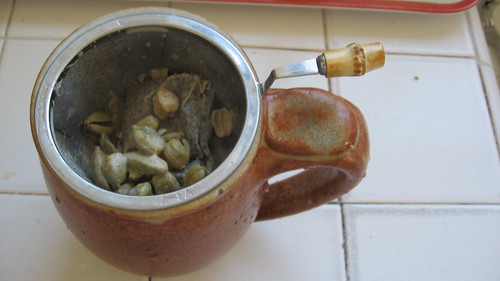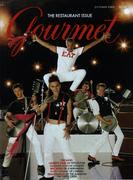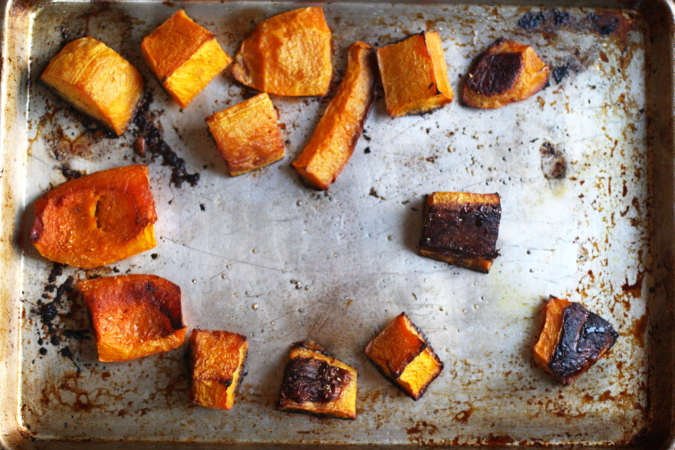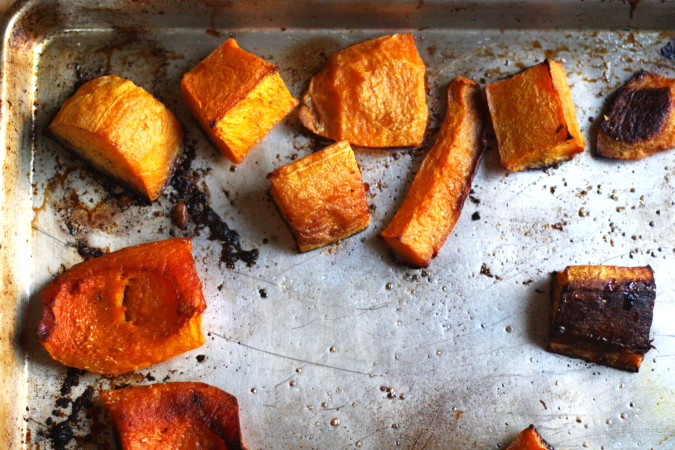BACK HOME
I unload my farmer’s market finds and start prepping. I quickly glance at my copy of Soffrito. The recipe for Ragu is about seven pages—including a lovely picture of a finished Ragu and a three page essay on meat sauces. I force myself to skim the dense paragraphs describing the history of meat sauces and stop at the list of ingredients for the Ragu.
1 1/4 lbs of beefsteak (sirloin, rib eye or round steak)
1 pork sausage
2 chicken livers
1 chicken neck
1 large or 2 small red onion, minced
1 carrot, peeled and minced
1 large stalk celery, minced
½ cup extra virgin olive oil
½ cup dry red wine
salt
2 fresh or canned tomatoes, peeled
4 cups water
1 piece of lemon zest, cut into thin strips
2-3 tablespoons of butter for dressing the pasta
1 cup Parmesan cheese for serving
Though the list of ingredients calls for beefsteak, it isn’t until I start reading the actual recipe that I realize I was supposed to ask the butcher to mince the meat for me. Upon further reading, Vitali suggests strongly that the butcher must only put the meat through the mincer once in order to “prevent excessive flaccidity.” I try to imagine myself returning to the meat counter with my sirloin and asking the old man for a shot at the mincer. I made a fool of myself in front of him once today. There is no way I’m going back there.
Luckily, a few sentences later, Vitali says a good home mincing is also an ideal for a ragu, but warns the reader that it is not only time consuming, but requires “a certain skill.” Hoping I have the innate skills needed, I commence mincing.
Based on the size of my dice, I decide I have quite possibly succeeded in making a somewhat proper mince. I begin my soffritto and heed Vitali’s advice to do nothing but observe the cooking process of these key three ingredients.
I marvel at the smells of this holy trinity
and admire the way the heat and oil changes the texture of the vegetables over time.
What was once clearly separate becomes one in velvety texture. It is at this point, when the soffritto gets to the “moment before it burns” I toss in the meat and let it brown.
As I do I read Vitali’s advice with the hunger of a starved pupil.
“Don’t be seduced into forgetting what you are doing and letting browning turn to burning. In this recipe you work at full attention, monitoring all operations…as the browning of both the soffritto and the meat should stretch your attention to the maximum. You will need all your senses, including the olfactory one, to prevent disaster.”
I tell myself Vitali is my greatest teacher yet, and continue on. If anyone can teach an Anglo Saxon how to cook like an old school Italian, it’s Vitali. She describes the browning process as one of making the meat “suffer”. Without browning, she explains, the meat will taste like it was boiled.
Sure. Brown the meat. Got that. Check.
I brown the meat for 15 minutes, waiting for the tell tale “crust” to appear on the meat and on the bottom of the pan. When this begins to happen, I add ½ a cup of wine and let it cook off.
With the wine cooked off, I begin to add my two cans of peeled tomatoes.
After adding the first can I realize I have been using the wrong pan for the job.
I re-read the recipe and discover that Vitali calls for a 10 inch diameter POT, not a 10 inch in diameter PAN. Suddenly, I am forced to move all cooking operations into the right sized container.
***It is this moment here, when things began to go astray, that I should have realized there was something wrong. I should have turned off the heat, stepped away from the stove and re-read Vitali’s 7 page recipe. Had I done that, dear reader, I might have discovered that the recipe called for TWO TOMATOES. Not TWO CANS of peeled tomatoes. It’s embarrassing to admit, but I definitely have problems with paying full attention to the little (and some times big) details. Just ask my husband. He’d be the first one to say with a smile that I am one quick moving person of the Aries persuasion. ***
With my meat and two cans (blush) of peeled tomatoes transferred to a pot, I am ready to add the 4 cups of water to the sauce. I lower the flame to minimum, add salt, pepper and lemon zest and leave it for 2 hours.
At the end of the cooking time (no wonder it took my sauce about an hour more to cook down), I remove the chicken neck and pull the meat off the bone. I toss the bones and return the chicken neck meat to the sauce. Delish! While I cook the pasta, I heat up my oven to 100 degrees so I can warm my pasta dishes.
When the pasta is al dente, drain and save some pasta water for thickening the sauce. Pour a ladleful of sauce into the bottom of the pasta bowl with a dab of butter.
Add a serving of drained pasta in the pasta bowl and add more sauce. Turn the pasta with a fork and spoon so as to blend it and serve immediately with grated Parmesan cheese.
Though the meal was a success (the house smelled like Casalinga a favorite Italian trattoria), I know I sti
ll have much to learn. The ragu would have been a true meat sauce had I followed the directions to a T. What I ended up with was a saucy meat sauce.
I have to admit, this dish as prepared, was amazing. Next time, I shall try it with the requested TWO TOMATOES and see what the difference is!






